#Best CAD Software for Beginners
Explore tagged Tumblr posts
Text
Easiest CAD Program For Beginners
Unlock your creative potential with the best 3D CAD software for beginners. From simple sketches to intricate designs, empower your ideas to take shape seamlessly. For more details, Visit: https://www.glickgroupglobal.com/best-3d-cad-software-for-beginners-to-pros-2020/
1 note
·
View note
Note
Hey! I love your art so much 💖 I wanted to ask what program you use for 3D modelling?
aw thank you!! :3
and to answer your question i’m going to warn you this is going to be kinda long because i’m gonna use this post as an excuse to show my 3D models that aren’t awful (sorry lol).
i actually use two different programs, both for different purposes, but you don’t need to get both, it really depends on which kind of modeling you want to do.
1) the first is called Nomad Sculpt on the iPad, you do have to pay for it unfortunately but it’s definitely one of the best modeling apps for the iPad. i know Blender is free but my computer is really old and doesn’t run the program very well, and at this point i’ve already gotten used to nomad sculpt.
anyway tho, i use it for art-related things like the obvious 3D models, but recently i’ve been playing around with just making scenes to use as references for my drawings. they’re not anything impressive, most of the time i actually use it to make little figurines to print and turn into earrings/little friends that sit in my room just for fun.
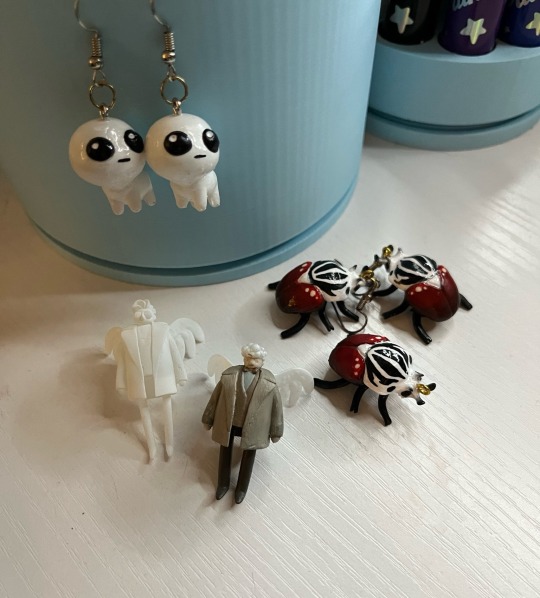
i’m gonna show this first bc they look cooler once they’re printed and colored (also you can tell i printed mini crowley and aziraphale when my sonadow hyperfixation started bc i never actually painted crowley) (he’s just kinda sitting there oops).
the little red guys are actually my favorite bugs (goliath beetles), i made them about a year ago but i still wear them like every day.
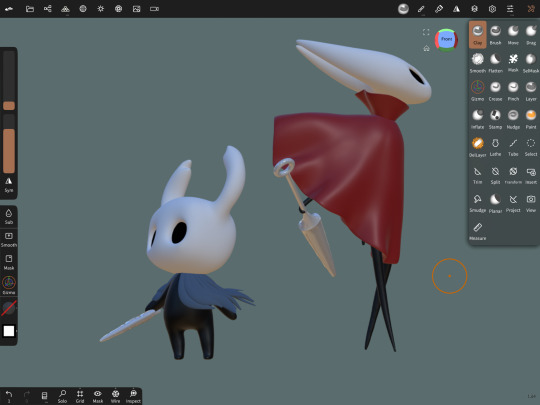
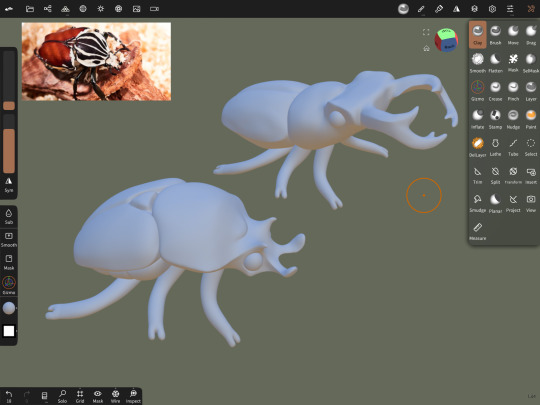
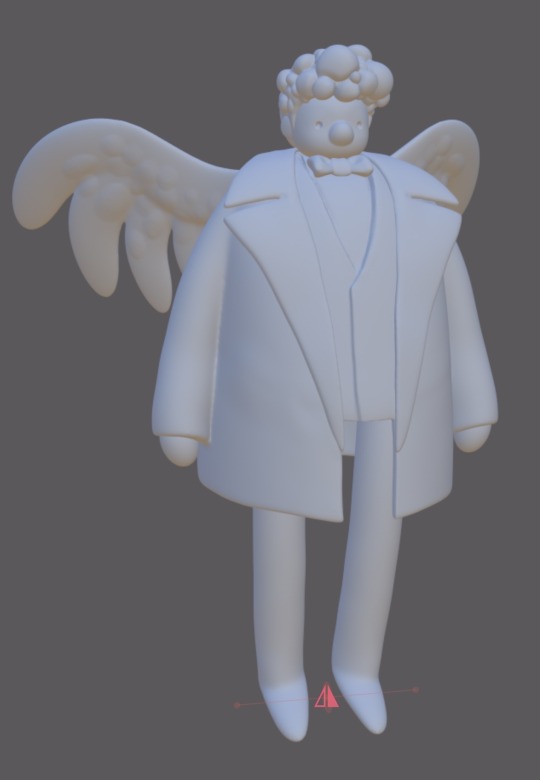
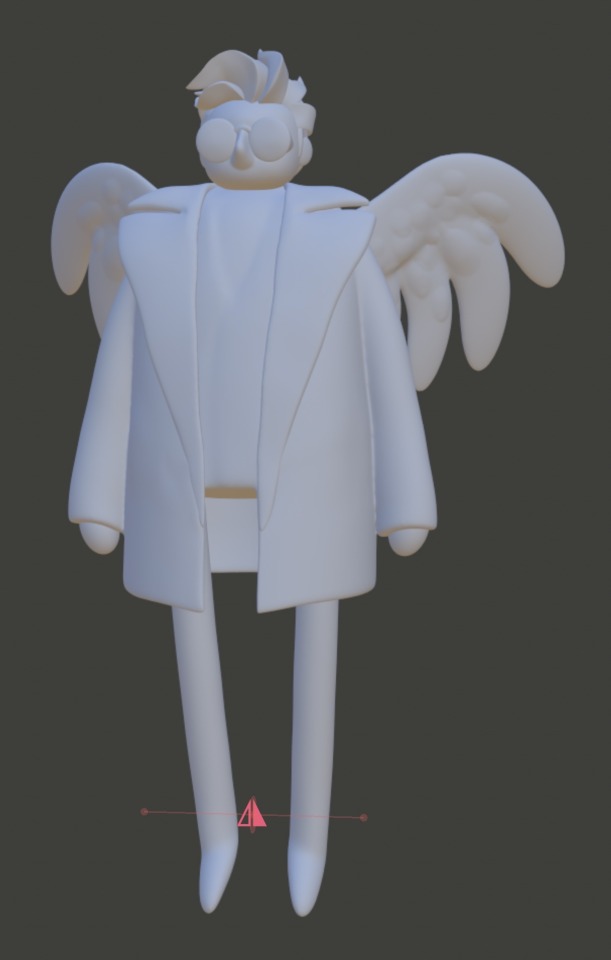
and here’s what they look like in the app, it’s a little intimidating but once you get used to it it’s actually kinda fun just playing around and seeing what you can do.
2) the second program i use is Shapr3D (also for the iPad, but i think they made an update where you can run it on windows/mac). you also have to pay for this as a subscription which sucks, i’m only able to use it since the engineering program i’m in pays for it.
Shapr3D is one of the many CAD software programs out there, but it’s nice bc it’s very beginner friendly and very easy to use. CAD is mainly for architecture/engineering but i honestly think more 3D artists should give it a try. it’s really nice once you get the hang of it and (i’m probably biased bc i’m a student) i honestly prefer it over just normal modeling software because i feel like you can be a lot more creative with it.
right now for my engineering class, our semester final is to design and present something that’s functional, and we can either explain the math behind it or just 3D print it and demonstrate how it works, and i’m making a functional mini model of “the rack” trap from Saw III (i’m not psychotic i swear i’ve just had a Saw hyperfixation for 5 years).
i’m definitely gonna post it when it’s finished just bc i’m already excited with how it’s turning out, but for now here’s a couple at-home projects i’ve done:
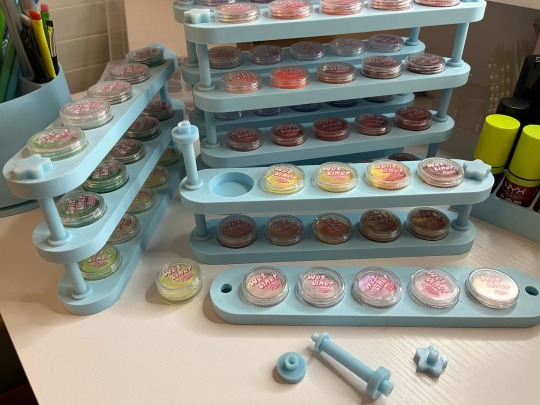
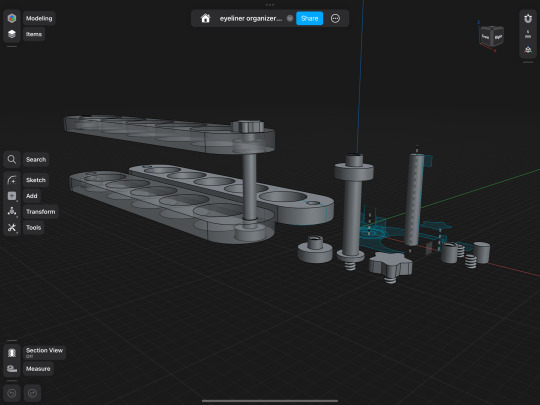
(above) i have a bunch of wet liners and i designed a stackable holder thingy with bolts between the shelves and a little cute star screw to fasten it at the top.
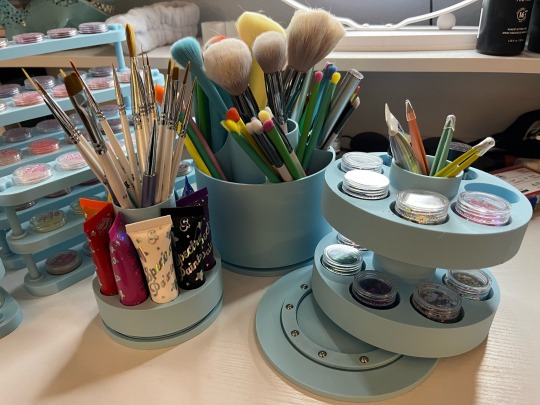
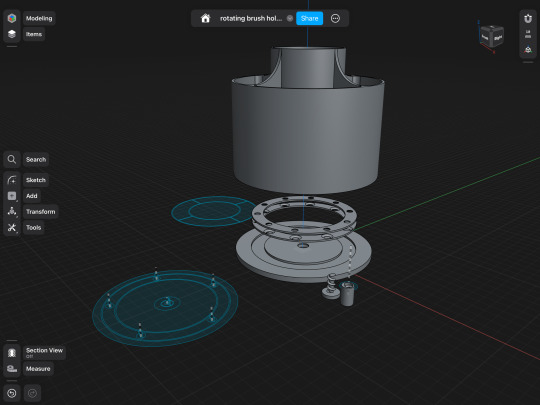
(above) i also made a few rotating brush holders at home (bc the ones that actually rotate are like $40 for some reason) by buying a set of small sphere bearings at home depot for like $5 (that’s what those little metal things are inside the third one, i took it apart bc i don’t know how to put a video and a picture in the same post) (just pretend they’re spinning rn).
anyway that’s all!! if you actually read this whole thing i love you so much bc engineering and design is one of my special interests so thanks for letting me tell you about the silly things i’ve made :3
#asks#3d art#3d model#engineering#infodump#special interest#ermmmmm not sure what else to tag#this was just a really long post lol#bugs#good omens#autism creature
82 notes
·
View notes
Text
Jewellery Designing Course in Delhi by NIDG Worldwide: Your Path to a Creative Career
Jewellery designing is not just an art; it is a way of expressing creativity, elegance, and culture through beautiful pieces of ornamentation. The Jewellery Designing Course in Delhi offered by NIDG Worldwide is one such platform that helps aspiring designers turn their passion into a profession. This comprehensive course is tailored to teach the nuances of designing, creating, and understanding the intricacies of jewellery in the best possible way.

What Makes Jewellery Designing a Great Career?
The jewellery industry in India is growing rapidly. With an increasing demand for exclusive and unique jewellery pieces, the need for skilled designers has also surged. A Jewellery Designing Course in Delhi opens up a plethora of opportunities for individuals who have an eye for detail and a passion for design. Whether you aspire to be a professional designer or wish to start your own jewellery brand, a structured course helps you get a strong footing in the industry.
Why Choose NIDG Worldwide?
NIDG Worldwide is a well-known name in the field of jewellery designing and training. Their Jewellery Designing Course in Delhi stands out due to the institution’s commitment to providing practical, hands-on learning experiences. Let’s explore the reasons why NIDG Worldwide should be your preferred choice:
Expert Faculty: The institution boasts a team of experienced professionals and industry experts who are passionate about passing on their knowledge. They provide the right mix of theoretical learning and practical training, helping students grasp essential design concepts and techniques.
Comprehensive Curriculum: The course covers everything from basic sketching to advanced computer-aided design (CAD). Students learn about various aspects like gemstone settings, metal crafting, and even digital jewellery design. The structured approach ensures that students are well-versed in all facets of jewellery designing.
State-of-the-Art Facilities: NIDG Worldwide offers modern infrastructure and up-to-date tools and software. Students get hands-on experience with professional-grade equipment and software that are widely used in the industry.
Career Guidance and Placement Support: At NIDG Worldwide, the focus is not just on teaching but also on helping students find the right career path. They offer placement assistance and guide students in setting up their own ventures or finding opportunities in reputed design houses.
Course Highlights
The Jewellery Designing Course in Delhi by NIDG Worldwide is structured to cater to beginners as well as professionals looking to upgrade their skills. Here are some highlights of the course:
Introduction to Jewellery Design: Understanding the fundamentals of jewellery design, including design theory, principles, and history.
Sketching and Rendering: Learning to sketch jewellery designs by hand and rendering them with shading and highlighting techniques to give a realistic feel.
Gemology Basics: An introduction to gemstones, their properties, and how they are used in different types of jewellery. Students gain knowledge of identifying various stones and using them appropriately in their designs.
CAD for Jewellery Design: Mastering computer-aided design (CAD) software to create precise, professional jewellery designs. Students learn to transform their sketches into detailed digital designs, preparing them for real-world projects.
Manufacturing Techniques: Understanding the processes involved in turning designs into actual jewellery pieces, including casting, metal forming, and stone setting.
Market Trends and Client Interaction: Learning about the latest trends in the jewellery market and how to interact with clients to understand their preferences and requirements.
Benefits of Enrolling in a Jewellery Designing Course
A Jewellery Designing Course in Delhi can be a stepping stone for anyone aspiring to enter this glamorous industry. Here are some key benefits of enrolling in this course:
Skill Development: You will acquire specialized skills in jewellery sketching, designing, and crafting, which will give you an edge in the competitive industry.
Creative Expression: Jewellery designing is all about expressing creativity and originality. Through this course, you will learn how to bring your creative ideas to life.
Career Opportunities: From working with established jewellery brands to launching your own business, a professional course opens up numerous career avenues.
Networking: Being a part of a reputed institution like NIDG Worldwide allows you to connect with industry experts, designers, and fellow students. Networking can help you find mentors, collaborators, and job opportunities.
Who Can Join?
The Jewellery Designing Course in Delhi by NIDG Worldwide is ideal for anyone with a passion for jewellery and design. Whether you are a student, a working professional looking for a career change, or someone keen on starting your own jewellery line, this course is designed to meet your needs. No prior experience is required, and the course is structured to build your skills from scratch.
Conclusion
In conclusion, a Jewellery Designing Course in Delhi by NIDG Worldwide offers a well-rounded education in the art and business of jewellery. It empowers aspiring designers with the knowledge and skills required to succeed in the industry. The course not only covers traditional designing methods but also introduces modern techniques and technologies. With expert guidance, hands-on training, and a focus on practical learning, NIDG Worldwide prepares students to excel in this competitive field.
If you have a flair for creativity and a desire to create stunning jewellery pieces, enrolling in a Jewellery Designing Course in Delhi could be your gateway to a fulfilling career. Take the first step towards your dream career with NIDG Worldwide, and let your creativity shine!
2 notes
·
View notes
Text
Beginner Guide to Computer Aided Design


When there was no any CAD tool, Mechanical Draftsman uses drafter to create the technical drawing Since last two-decade creation of manufacturing drawing has been changed a lot with the help of modern CAD software like SolidWorks, Creo, CATIA and Autodesk Inventor. CAD software helps engineer to create, modify, and optimize designs. In simple words CAD is defined as use of computer programs to create two- or three-dimensional graphical representations of physical objects. Initially CAD program were used in electronic and electrical industry like design electronic circuit with the help of block. Any CAD program reduces the cost of organization because an engineer easily modifies the 3D model and update the drawings. organizations like CAD program because it reduces the cost of modifying prototypes and purchasing parts. Now a day it does not matter what type of operating system you use major CAD program comes for all major operating system like Mac OS X, Windows, and Linux best example is FreeCAD. so far we have understood Computer Aided Design Software lets understand what are the major benefits of using CAD program. Better Visualization: If you are using AutoCAD then it is very hard to visualize the shape of manufactured product but if you using modern CAD software then it is very easy to visualize finished product, sub-assemblies, and component parts of a CAD system significantly speeds up the design process. Better Accuracy: Modern CAD Tool provide better accuracy in term of measured dimension, Applied material, weight calculation etc. therefore, CAD tool helps in reduction of errors made by engineer in technical drawing. Easy to use: CAD program are easy to use almost all major tool same in all program for example Extrude cut in SolidWorks is known as pocket in FreeCAD and perform the same function. If you have learned one CAD program, then you can learn other CAD program very easily. CAD program are getting smarter day by day I hope in near future we will have AI tool for mechanical design as well where AI will be able to create model based on design input. I am very happy to see that open source CAD program are improving day by day. FreeCAD is a big hope for small scale industries because these industries cannot afford propriety CAD software like SolidWorks and Autodesk Inventor. “Thank you for reading! If you found this article insightful and valuable, consider sharing it with your friends and followers on social media. Your share can help others discover this content too. Let’s spread knowledge together. Your support is greatly appreciated!” Read the full article
1 note
·
View note
Text
Best Institute for SolidWorks 3D Design Course Career Opportunities – Why Silicon Institute Stands Out
If you're searching for the best institute to learn SolidWorks 3D Design and unlock real career opportunities, Silicon Institute is a top choice in the UAE. Known for its project-based training, expert mentors, and personalized student support, the institute offers a well-rounded SolidWorks course that not only teaches the software but also prepares you for the job market, freelancing, and higher education in the field of design and engineering.
What makes Silicon Institute the best?
Beginner-friendly curriculum—no prior experience needed
Hands-on projects—real-world 3D modeling, assembly, and simulation tasks
Industry-relevant skills—aligned with current CAD and product design trends
International certification—boosts your professional credibility
Flexible learning options—online, offline, weekend, and evening batches
Career-focused outcomes—portfolio building, job assistance, and freelance guidance
From students and engineering aspirants to working professionals upgrading their skills, Silicon Institute helps learners at every level achieve meaningful outcomes.
Want to study at the best place for SolidWorks training? Visit www.sindso.com and start your career in 3D design with Silicon Institute today!
#futureinnovators#siliconinstitute#codingforkids#roboticsforkids#stemeducation#arduinoforkids#creativelearning#stemeducationdubai
0 notes
Text
3D Printers: Everything You Need to Know About 3D Printing Technology
3D printers have revolutionized the way we design, develop, and manufacture products. From creating rapid prototypes in the industrial sector to printing miniatures at home, 3D printing technology has expanded across industries, offering endless possibilities. In this article, we will explore what 3D printers are, how they work, the types of 3D printers available, and the best options for different use cases.
What Are 3D Printers?
A 3D printer is a device that creates three-dimensional objects from a digital file using additive manufacturing. Unlike traditional subtractive methods (like cutting or drilling), 3D printers build objects layer by layer using materials like plastic, resin, or metal. This technique reduces material waste, increases efficiency, and opens up innovative design possibilities.
How Do 3D Printers Work?
3D printing begins with creating a digital design using Computer-Aided Design (CAD) software. This design is then converted into a file format called STL (Standard Tessellation Language), which is interpreted by slicing software to divide the model into horizontal layers. The 3D printer reads this file and prints the object layer by layer.
The process generally involves the following steps:
Design the model using CAD software.
Slice the model into printable layers using slicing software.
Choose the right 3D printer and material.
Print the object layer by layer.
Post-process the object if needed (cleaning, curing, sanding).
Types of 3D Printers
There are several types of 3D printers, each using different technologies and materials. Understanding the different types of 3D printers is key to selecting the right one for your needs.
1. Fused Deposition Modeling (FDM)
FDM 3D printers are the most common and affordable type. They work by melting plastic filament and extruding it through a heated nozzle. These printers are ideal for beginners, hobbyists, and prototyping.
Materials used: PLA, ABS, PETG, TPU
Pros: Affordable, easy to use, wide material support
Cons: Visible layer lines, limited detail resolution
2. Stereolithography (SLA)
SLA 3D printers use a UV laser to cure liquid resin into hardened plastic. They offer higher precision and smoother finishes, making them perfect for dental models, jewelry, and detailed prototypes.
Materials used: Photopolymer resin
Pros: High resolution, smooth finish
Cons: Resin handling and post-processing required
3. Digital Light Processing (DLP)
Similar to SLA, DLP printers use a digital light projector to cure resin. DLP is faster than SLA and is often used in professional-grade applications like engineering and medical modeling.
Materials used: UV-sensitive resin
Pros: Fast, accurate, ideal for small parts
Cons: Expensive, messy post-processing
4. Selective Laser Sintering (SLS)
SLS 3D printers use a laser to fuse powdered material (usually nylon) into solid objects. This type is used for functional parts, low-volume production, and complex geometries.
Materials used: Nylon, polyamides, TPU
Pros: Strong, functional parts, no support structures
Cons: Expensive and industrial-focused
5. Metal 3D Printing (DMLS & SLM)
Direct Metal Laser Sintering (DMLS) and Selective Laser Melting (SLM) are used for metal printing. They are primarily employed in aerospace, automotive, and medical industries.
Materials used: Stainless steel, aluminum, titanium
Pros: Durable, end-use metal parts
Cons: High cost, industrial use only
Uses of 3D Printers Across Industries
3D printing is no longer limited to just prototyping. Here are some of the top applications of 3D printers today:
1. Prototyping and Product Development
Startups and engineers use 3D printers for rapid prototyping, which reduces design time and cost.
2. Medical and Dental
3D printers produce customized implants, dental crowns, surgical guides, and even prosthetics.
3. Education
Schools and universities use 3D printers for STEM education, encouraging students to innovate and experiment.
4. Architecture and Construction
Architects create detailed building models and construction firms explore 3D printing for housing solutions.
5. Fashion and Jewelry
3D printers are used to design intricate jewelry molds and experimental fashion pieces.
6. Automotive and Aerospace
Car and airplane manufacturers use 3D printing to create lightweight, strong parts that reduce production time and weight.
Best 3D Printers in 2025
Here are some of the best 3D printers across different categories in 2025:
1. Best Budget 3D Printer – Creality Ender 3 V3 SE
Affordable and beginner-friendly, the Ender 3 V3 SE offers reliable prints for under $300.
2. Best Resin 3D Printer – Anycubic Photon Mono M5s
High-resolution resin printer perfect for miniatures and dental applications.
3. Best Professional 3D Printer – Prusa i3 MK4
A reliable, open-source printer known for quality and community support.
4. Best Industrial 3D Printer – Formlabs Fuse 1+ SLS
A powerful SLS printer for businesses needing functional prototypes and end-use parts.
How to Choose the Right 3D Printer
If you're looking to buy 3D printers, consider the following factors:
Purpose: Are you using it for hobby, education, or industry?
Material Compatibility: Choose a printer that supports the materials you need.
Build Volume: Consider the size of the objects you plan to print.
Ease of Use: Beginners should look for plug-and-play models.
Customer Support: A reputable brand with good support is essential.
Budget: Prices range from $200 to over $10,000 depending on capabilities.
Future of 3D Printing Technology
The future of 3D printing is evolving rapidly. Advances in multi-material printing, bio-printing, and AI-driven design are reshaping what's possible. We may soon see entire homes, organs, and complex machinery being 3D printed with unparalleled precision.
As 3D printing becomes more accessible, it will continue to disrupt traditional manufacturing, enabling decentralized production, on-demand manufacturing, and increased sustainability.
Conclusion
3D printers have transformed how we create, innovate, and manufacture. Whether you're a hobbyist printing models at home, a business developing prototypes, or a professional looking for precision and efficiency, there’s a 3D printer tailored for your needs. As the technology continues to advance, now is the perfect time to explore the world of 3D printing.
If you're looking to buy the best 3D printer or want to understand which type of 3D printer suits your needs, use this guide to make an informed decision. The future of manufacturing is here—layer by layer.
0 notes
Text
Selecting a CPU for architectural design: balancing the number of cores with the clock speed

Depending on the particular requirements of your workflow, especially whether you value rendering speed (multi-core tasks) or overall modeling and drafting responsiveness (single-core tasks), the best CPU for architecture design will vary.
A powerful CPU with a high core count is advised for architectural design, particularly for operations like rendering and handling intricate models. In general, an Intel Core i7/i9 or AMD Ryzen 7/9 series CPU is sufficient, with a higher number of cores providing greater performance for rendering and other demanding workloads. Think about using an Intel i7 or Ryzen 7 as a starting point for a nice balance between cost and performance.
Key Considerations:
• Number of Cores: In general, more cores result in greater performance in rendering and other computationally intensive operations.
• Clock Speed: In single-threaded activities, such as CAD and some architectural software, higher clock speeds can enhance performance.
• Intel vs. AMD: For architectural design, both Intel and AMD provide fantastic CPUs. The value and large number of cores in AMD Ryzen processors are frequently praised, while Intel processors are frequently preferred for their single-core performance.
• Rendering: High core numbers are particularly beneficial for CPU-based rendering.
• Software Compatibility: Make sure the CPU you select works with the software you'll be using, such Revit, Rhino, ArchiCAD, SketchUp, and rendering engines like Enscape, Lumion, or V-Ray.
Particular CPU Recommendations:
• AMD Ryzen 7/9: Because they have a decent mix of core count, clock speed, and value, these CPUs are a great option for architectural design.
• Intel Core i7/i9: These CPUs are renowned for their outstanding single-core performance and are ideal for challenging architectural applications.
• AMD Ryzen Threadripper PRO: The Threadripper PRO series is made for demanding applications like reality capture and rendering, and it provides exceptionally high core counts (up to 96) for users who require maximum performance.
Suggested CPU choices:
1. Premium CPUs for rendering and demanding projects
• AMD Ryzen 9 7950X With 16 cores and 32 threads, this CPU shines in multi-threaded programs and delivers lightning-fast clock rates for seamless rendering.
• Intel Core i9-13900K : It has 32 threads and 24 cores (8 Performance-cores and 16 Efficient-cores), which enable it to perform exceptionally well in rendering jobs with high clock speeds.
2. Mid-range CPUs for a balanced performance
• AMD Ryzen 7 5800X : It offers strong multi-core performance and excellent single-threaded performance for a lower price, thanks to its 8 cores and 16 threads.
• Core i7-12700K from Intel : It is a dependable and affordable choice for numerous architectural projects due to its excellent mix of multi-core performance and clock rate.
3. Entry-level CPUs for smaller tasks and simple design
• AMD Ryzen 5 5600X : A cost-effective choice with six cores and twelve threads, ideal for simple to somewhat complicated architectural rendering projects.
• Intel Core i5-12600K : With 10 cores (6 performance cores and 4 efficient cores) and 16 threads, it is perfect for beginners and excels at a variety of rendering applications.
Additional Important components:
• RAM: With 64GB or more suggested for larger and more complicated tasks, 32GB of RAM is a solid place to start while working on architecture.
• GPU: At least 6 GB of VRAM on a dedicated graphics card is necessary for seamless rendering and viewport performance.
• Storage: With larger SSDs (1TB or more) recommended for larger projects, an SSD is essential for quick loading times and responsiveness.
You may select a CPU that provides the finest combination of performance and value for your architectural design workflow by taking into account your unique requirements and priorities regarding architectural workstation .
0 notes
Text
Transforming Infrastructure and Design: The Ultimate Guide to Civil CAD Training and Courses in Pune
In today’s rapidly evolving construction and interior design industries, proficiency in Civil Engineering Software has become a game-changer. As infrastructure projects grow in complexity and aesthetic standards rise in interior spaces, the demand for skilled CAD professionals surges. For aspiring civil engineers, architects, and interior designers in Pune, gaining specialized training in Civil CAD and related courses can significantly enhance career prospects and project outcomes. This article explores the importance of Civil CAD training, available courses in Pune, and how mastering these tools can open new avenues of success.
The Growing Significance of Civil Engineering Software Courses in Pune
Pune, known as the education and innovation hub of India, is witnessing exponential growth in infrastructure development and architectural design. As a result, Civil Engineering Software Courses in Pune have gained immense popularity among engineering students, professionals, and entrepreneurs. These courses focus on equipping learners with the latest software skills essential for drafting, modeling, and project management.
Civil engineering software such as AutoCAD, Revit, STAAD.Pro, and Civil 3D are fundamental tools that streamline design processes, improve accuracy, and facilitate collaboration among project teams. Enrolling in these courses enables participants to understand industry standards, learn best practices, and stay competitive in a thriving job market. Moreover, many institutes offer tailored programs catering to various skill levels, from beginners to advanced users.
Civil CAD Training in Pune: Bridging the Gap Between Theory and Practice
Civil CAD training in Pune offers a comprehensive learning experience that combines theoretical knowledge with practical application. These training programs are designed to help professionals and students develop expertise in creating detailed civil drawings, structural models, and infrastructure layouts.
The benefits of undertaking Civil CAD training include improved technical skills, increased productivity, and enhanced employability. Trainees learn to interpret project requirements accurately, produce precise drawings, and adapt to the evolving technological landscape of civil engineering. Additionally, many courses incorporate real-world projects and industry case studies, providing hands-on experience that is highly valued by employers.
For those looking to specialize further, advanced courses delve into complex modeling, simulation, and optimization techniques. Whether you're an aspiring civil engineer or an experienced professional seeking to upgrade your skills, civil CAD training in Pune is an invaluable investment in your career development.
Exploring CAD Course for Interior Design: Merging Creativity with Technology
Interior design is no longer limited to manual sketches and physical models; it now heavily relies on sophisticated CAD tools. A CAD course for interior design equips students with the skills to create detailed floor plans, 3D visualizations, and realistic renderings, bringing interior concepts to life with precision and flair.
This course is particularly beneficial for interior designers looking to enhance their presentation quality and streamline project workflows. By mastering CAD software, designers can experiment with different layouts, materials, and lighting schemes virtually before implementation. This not only saves time and resources but also allows clients to visualize the final outcome more effectively.
Furthermore, many interior design CAD courses emphasize the integration of interior design principles with technical drafting, ensuring that students can produce both aesthetically pleasing and structurally sound designs. The ability to produce detailed interior plans and renderings has become a standard expectation in the industry, making this skill set highly sought after.
CAD Interior Design: A Blend of Art and Engineering
The cad interior design segment is a specialized field that combines artistic creativity with technical expertise. It involves using CAD software to develop intricate interior layouts, furniture arrangements, and decorative elements that align with client preferences and functional requirements.
Professionals skilled in CAD interior design can efficiently communicate their ideas through detailed drawings and 3D models. This not only enhances client satisfaction but also facilitates smoother project execution. The technology enables designers to make modifications easily, experiment with various design options, and present realistic visualizations that help in decision-making.
In recent years, the integration of augmented reality (AR) and virtual reality (VR) with CAD interior design has further transformed the industry. These advancements allow clients to virtually walk through their future spaces, making the design process more interactive and engaging.
Why Choose Civil CAD and Interior Design Courses in Pune?
Pune’s educational landscape offers numerous opportunities to learn civil CAD and interior design skills through reputed institutes and training centers. The city’s thriving construction sector, coupled with a vibrant design community, creates an ideal environment for learners to grow and excel.
Opting for courses in Pune also provides access to industry experts, live projects, and placement assistance, ensuring that students are well-prepared for real-world challenges. Whether you aim to work in infrastructure development, urban planning, or interior decoration, these courses lay a strong foundation for your career.
0 notes
Text
How to Become a Fashion Designer After 12th – Step-by-Step Guide

Introduction
If you’ve just completed your 12th and have a passion for creativity, clothing, and design, then a career in fashion designing could be the perfect path for you. With fashion becoming a booming industry in India, students now have numerous opportunities to turn their passion into a rewarding profession. But where should you begin?
This guide will help you understand the step-by-step process to become a fashion designer after 12th, especially if you're located in areas like Yamuna Vihar or Uttam Nagar, where excellent training options are available.
Step 1: Understand the Role of a Fashion Designer
A fashion designer does more than just design clothes. From fabric selection to stitching, color coordination to software-based design, a fashion designer brings ideas to life. If you're aiming for a career in fashion designing in Yamuna Vihar or career in fashion designing in Uttam Nagar, it starts with having a strong foundation in both creative and technical skills.
Step 2: Choose the Right Course After 12th
After completing school, enrolling in a professional course is the most important step. Look for a fashion designing course in Yamuna Vihar or a fashion designing course in Uttam Nagar that is tailored for beginners and offers industry-oriented training.
These courses typically include:
Fashion sketching and illustration
Garment construction
Textile and fabric knowledge
Pattern making
CAD (Computer-Aided Design)
For those looking for flexibility, you can also explore an online fashion designing course in Yamuna Vihar or an online fashion designing course in Uttam Nagar that allows you to study from home.
Step 3: Start with Beginner-Friendly Classes
If you’re starting from scratch, don’t worry. There are fashion design classes for beginners in Yamuna Vihar and fashion design classes for beginners in Uttam Nagar that are perfect for students fresh out of school. These classes are designed to build your foundation in illustration, color theory, and fabric knowledge.
Just search fashion designing classes near me in Yamuna Vihar or fashion designing classes near me in Uttam Nagar to find options near your location.
Step 4: Learn Through Online & Offline Modes
Today’s education system supports both physical and virtual learning. If you prefer a home-based setup, choose fashion designing online classes in Yamuna Vihar or fashion designing online classes in Uttam Nagar. These classes include live interactive sessions, assignments, and personal mentoring.
If you want more hands-on experience, opt for institute-based training, which may offer facilities like sewing labs and portfolio workshops.
Step 5: Earn a Recognized Certification
A fashion designing certification course in Yamuna Vihar or Uttam Nagar helps validate your skills and adds credibility when applying for internships or jobs. These certifications are typically awarded after completing projects and clearing assessments.
They not only improve your portfolio but also help you stand out in interviews and college applications.
Step 6: Go for Professional Training with Placement Support
Once you're confident in your basics, upgrade to a fashion design professional training in Yamuna Vihar or Uttam Nagar. These courses provide advanced-level knowledge, including:
Portfolio development
Real-world garment design projects
Internship programs
Styling and fashion shows
Fashion business basics
For career-minded students, it’s best to select a fashion designing course with placement in Yamuna Vihar or Uttam Nagar, where institutes support job connections and placement assistance.
Step 7: Learn from the Best Institute
Choosing the right place to learn is just as important as the course itself. A best fashion designing institute in Yamuna Vihar or best fashion designing institute in Uttam Nagar should offer:
Qualified trainers with industry experience
Updated curriculum
Practical labs and workshops
Internship and job placement services
Always visit the institute, attend demo sessions, and talk to previous students before making a final decision.
Final Thoughts
Becoming a fashion designer after 12th is an exciting and fulfilling journey. From learning how to sketch your first design to creating a full-fledged fashion portfolio, each step brings you closer to a rewarding career.
Whether you're searching for a fashion designing course in Yamuna Vihar or an online fashion designing course in Uttam Nagar, what matters most is your dedication, passion, and choice of training.
So take the first step today—and start shaping your dream career in fashion design.
Suggested Links: –
Learn Fashion Styling
Dress Design Expert
Learn the art of Hand Embroidery
Pattern Making in Dress Designing
#become a fashion designer#fashion desingers#fashion designing course#FashionCareer#FashionDesignInstitute#FashionDesigningSkills#FashionDesignTraining#CareerInFashion
0 notes
Text
Build Your Future with the Best Interior Designing Institute in Lucknow
Are you passionate about transforming spaces with creativity and style? A career in interior designing can be your perfect choice. If you’re looking to pursue a professional interior designing course in Lucknow, choosing the right institute is the first and most important step.
At Design Gateway, we offer industry-oriented interior designing training in Lucknow that blends creativity with technical expertise. Our institute is known for providing high-quality education, practical exposure, and expert guidance to students who aim to build a successful career in the world of design.
Why Choose Design Gateway?
As one of the best interior designing training institutes in Lucknow, Design Gateway provides a well-structured curriculum that covers everything from basic design principles to advanced interior planning. Whether you are a beginner or someone looking to upskill, our courses cater to all levels.
Our key offerings include:
Hands-on training with real-time projects
Guidance from experienced faculty and industry professionals
Portfolio development and placement assistance
Workshops, guest lectures, and site visits for practical learning
What You Will Learn
During the course, students will explore essential areas like:
Space planning and layout design
Color theory and lighting techniques
Furniture design and materials
CAD software and 3D visualization tools
Our goal is to make each student job-ready by the end of the course.
Scope of Interior Designing in Lucknow
With the growing demand for smart homes, commercial spaces, and aesthetic interiors, interior designing is a booming field in Lucknow. Whether you want to work with an established firm, become a freelance designer, or start your own business, the opportunities are endless.
Start Your Design Journey Today
If you’re serious about a career in interior designing, don’t settle for less. Join the best interior designing institute in Lucknow — Design Gateway — and turn your passion into a profession.
Visit our institute or contact us to know more about admission, course duration, and fee structure. Let’s build your future in design together!
0 notes
Text
AutoCAD Mechanical for Beginners: The Smartest Way to Enter the Design & Manufacturing Industry

Introduction
In today's fast-evolving engineering and manufacturing landscape, design precision and digital tools have become the backbone of innovation. Whether you're a mechanical engineering student or a beginner aiming to explore a technical career, learning AutoCAD Mechanical is one of the smartest decisions you can make.
AutoCAD Mechanical is a specialized version of AutoCAD, tailored specifically for mechanical design, 2D drafting, and product development. It not only helps streamline the design process but also prepares students for real-world mechanical engineering projects. And the best part? You don’t need to be an expert to start. Beginners can now learn AutoCAD Mechanical from scratch and grow into professional designers with the right training.
Why Beginners Should Choose AutoCAD Mechanical
AutoCAD Mechanical simplifies complex design tasks with built-in libraries, standards-based tools, and automation features. This means beginners can focus on understanding design concepts rather than getting stuck in technicalities.
Students enrolling in a certified AutoCAD mechanical design course in Yamuna Vihar or Uttam Nagar can expect to gain hands-on skills in mechanical drafting, part assembly, dimensioning, and industrial drawing standards. These skills are in high demand across industries like manufacturing, automotive, and construction.
From Beginner to Advanced: Your Path to Professional Growth
Many training institutes now offer beginner to advanced AutoCAD mechanical training in Yamuna Vihar and Uttam Nagar, giving students a structured learning path. These programs are crafted to gradually build your skills—from understanding the interface to executing complete mechanical drawings used in industry.
The curriculum often includes real-time projects, lab practice, and performance assessments. For students serious about a career in mechanical design, enrolling in a mechanical AutoCAD course institute in Uttam Nagar or Yamuna Vihar is a solid step toward becoming job-ready.
Learning AutoCAD Mechanical Near You: Why Location Matters
Proximity to quality education is crucial for students. That’s why local options like the top AutoCAD mechanical design institute in Uttam Nagar or the best AutoCAD mechanical training institute in Yamuna Vihar are gaining popularity. These institutes provide not just software training but also career guidance, project assistance, and placement support.
If you're searching for a mechanical design software training center in Yamuna Vihar or a mechanical AutoCAD course institute in Uttam Nagar, look for ones that offer practical labs, experienced faculty, and updated curriculum.
Placement Support and Career Opportunities
A major advantage of taking up AutoCAD mechanical training with placement in Uttam Nagar or Yamuna Vihar is the direct pathway into job roles such as CAD technician, mechanical draftsman, design engineer, and more. Industries today are on the lookout for candidates who are skilled with tools like AutoCAD Mechanical and have real project experience.
Many students who complete a certified AutoCAD mechanical design course in Uttam Nagar find themselves placed in design studios, engineering firms, and manufacturing units within months of completing the program.
Final Thoughts: Start Small, Think Big
Learning AutoCAD Mechanical might seem intimidating at first, but with the right support and structured training, it's entirely achievable—even for beginners. Whether you’re in college or just finished school, starting with a top AutoCAD mechanical design institute in Yamuna Vihar or an AutoCAD mechanical coaching center in Uttam Nagar could be the beginning of a strong and sustainable career in design and manufacturing.
So if you're ready to step into the future of mechanical design, now is the time to explore AutoCAD mechanical training in Yamuna Vihar or AutoCAD mechanical coaching centers in Uttam Nagar that combine foundational skills, advanced techniques, and job support—all in one program.
Suggested Links: –
AutoCAD Electrical Training
AutoCAD Civil Training
AutoCAD Mechanical Training
Architecture & Interior Designing
#autocad training in uttam nagar#autocad classes in yamuna vihar#autocad training in yamuna vihar#autocad classes in uttam nagar#mechanical autocad classes in uttam nagar#mechanical autocad classes in yamuna vihar#mechanical autocad training in uttam nagar#civil autocad classes in yamuna vihar
0 notes
Text
GIFT Fashion Institute in Kolkata – Enroll in 2025
Fashion Design Courses in Kolkata – GIFT Design Academy Leads the Way
Introduction: The Fashion Capital of Eastern India
Kolkata has always been synonymous with creativity, culture, and craftsmanship. From its rich heritage of textiles and handlooms to its contemporary edge in couture, the city has become an emerging epicenter for fashion education. Among the most reputed institutions offering fashion design courses in Kolkata, GIFT Design Academy has carved a name for itself through its exceptional teaching methodology, industry exposure, and career-oriented programs.
For those dreaming of a successful career in fashion, choosing the right fashion designing institute in Kolkata is crucial. GIFT Design Academy not only offers comprehensive fashion designing courses in Kolkata, but it also nurtures creative minds and transforms them into confident, skilled fashion professionals ready to thrive in the ever-evolving fashion industry.
Why GIFT Design Academy Is the First Choice for Aspiring Fashion Designers
1. Pioneer in Fashion Education
Founded over 25 years ago, GIFT Design Academy stands tall as a pioneer in design education in Eastern India. It is not just a fashion institute in Kolkata but a launchpad for those who aspire to lead the fashion industry with innovation and excellence. The institute is consistently ranked among the best fashion designing colleges in Kolkata due to its blend of creativity, technology, and practical learning.
2. Globally Aligned Curriculum
Fashion trends are dynamic and ever-changing. That’s why GIFT follows an internationally benchmarked curriculum that equips students with global design sensibilities. The courses are designed in sync with international fashion education standards and include modules that emphasize sustainability, fashion forecasting, digital design, and industry readiness.
3. Hands-on Industry Experience
Unlike many conventional fashion designing colleges in Kolkata, GIFT offers an industry-integrated model of education. From fashion shows to live design projects, internships, exhibitions, and brand collaborations, students at GIFT regularly interact with industry professionals. They gain exposure that makes them job-ready by the time they graduate.
GIFT’s Comprehensive Fashion Designing Courses in Kolkata
Whether you’re a high school graduate, a working professional, or someone looking to pursue your passion, GIFT offers multiple entry points through a range of fashion design courses in Kolkata. Each course focuses on developing creativity, technical skills, business acumen, and real-world experience.
1. Foundation Diploma in Fashion Design
Duration: 1 year Eligibility: 10th pass
This is an introductory program designed for students to understand the core principles of fashion. The course covers:
Fashion illustration & sketching
History of fashion
Basic draping & garment construction
Textile science
Introduction to fashion software (CAD)
Ideal for beginners, this course lays a strong foundation and prepares students for higher education in fashion.
2. Advanced Diploma in Fashion Designing
Duration: 2 years Eligibility: 10+2
This course is designed for those looking for in-depth training in both design and production. The curriculum includes:
Pattern making & advanced draping techniques
Apparel manufacturing & quality control
Fashion marketing and merchandising
Retail & e-commerce in fashion
Portfolio development
Industrial visits and fashion shows
Graduates of this program are equipped to enter the fashion industry as designers, merchandisers, stylists, or entrepreneurs.
3. B.Sc in Fashion Design (University-Affiliated Degree)
Duration: 3 years (6 semesters) Eligibility: 10+2 (any stream)
This academic degree is among the most sought-after fashion designing courses in Kolkata. Offered in collaboration with a recognized university, this program balances creativity with academic rigor.
Key subjects include:
Fashion Communication
Fashion Retail & Branding
Sustainable Fashion Practices
Fashion Forecasting
Design Studio Practices
Final-year design collection & runway show
This course is ideal for students seeking an academic qualification with career-ready skills.
4. Short-Term Fashion Design Certificate Courses
Duration: 3–6 months Eligibility: Open to all
These modular programs are excellent for those who want to explore specific areas of fashion, such as:
Fashion Styling
Fashion CAD & Photoshop
Surface Ornamentation Techniques
Hand Embroidery
Boutique Management
Perfect for working professionals or hobbyists who want to learn at their own pace.
What Makes GIFT the Best Fashion Designing Institute in Kolkata?
Expert Faculty & Mentorship
GIFT takes pride in its team of industry-experienced faculty who are not just teachers but mentors. They come from leading fashion backgrounds and bring practical experience from working with brands like Manish Malhotra, Sabyasachi, Zara, Pantaloons, and others. Their guidance helps students understand the real demands of the fashion industry.
Infrastructure That Inspires Creativity
GIFT boasts one of the most well-equipped campuses among fashion designing institutes in Kolkata. Facilities include:
Fashion design studios
Pattern-making and garment labs
Computer-aided design labs with the latest software
Textile testing laboratories
A fashion resource library
Auditorium for shows and seminars
This immersive environment stimulates creativity, experimentation, and collaboration.
Fashion Shows, Exhibitions, and Industry Events
GIFT organizes its own annual fashion event — GIFT Fashion Carnival — where students present their original collections to an audience of professionals, influencers, and recruiters. Such events give students confidence and visibility in the industry.
Career Prospects After Fashion Designing Courses at GIFT
A qualification from GIFT opens the door to a wide variety of exciting career paths in the global fashion industry. Graduates of GIFT have gone on to build successful careers in the following fields:
Fashion Design & Haute Couture
Many GIFT alumni are working as in-house designers with brands or have launched their own successful fashion labels.
Fashion Merchandising & Retail
Students trained in merchandising go on to work as buyers, product developers, and retail analysts for major fashion retailers and e-commerce platforms.
Fashion Styling & Image Consultancy
Graduates have also ventured into fashion styling, working with celebrities, media houses, magazines, and influencers.
Costume Designing for Film & Television
Kolkata being a hub for Bengali and Hindi cinema, many students explore costume designing opportunities in movies, OTT platforms, and television shows.
Entrepreneurial Success
A large number of GIFT students have become fashion entrepreneurs, boutique owners, and brand consultants.
GIFT’s Placement Support & Recruiter Network
GIFT Design Academy provides full placement support to students through:
Career counseling sessions
Interview preparation
Resume & portfolio workshops
Internship opportunities with leading brands
Top recruiters include:
Shoppers Stop
Pantaloons
Manyavar
Ritu Kumar
FabIndia
Raymonds
House of Anita Dongre
Aditya Birla Group
Fashion Designing Course in Kolkata Fees – Affordable Yet Premium
GIFT believes in providing world-class fashion education at affordable fees, making it accessible to students from all backgrounds. Here's a fee estimate:
Diploma Course: ₹80,000 – ₹1,20,000
Advanced Diploma: ₹1,50,000 – ₹2,00,000
Degree Program (B.Sc): ₹2,00,000 – ₹3,50,000 (entire course)
Certificate Courses: ₹15,000 – ₹40,000
Flexible payment plans, EMI options, and scholarships are also available for eligible students.
Student Testimonials – Voices That Inspire
Studying Fashion in Kolkata – Why It’s the Right Choice
Rich Textile Heritage
Kolkata is home to legendary textiles like Baluchari, Kantha, and Jamdani. This cultural wealth offers endless inspiration for designers.
Artistic & Cultural Vibrancy
From literature and cinema to fine arts and theater, the city has always been a hotbed of creativity — a perfect breeding ground for fashion innovation.
Affordable Living with Global Exposure
Unlike many metropolitan cities, Kolkata offers affordable education and living, making it ideal for outstation students who want quality education without excessive costs.
How to Apply to GIFT Design Academy?
Applying to GIFT is simple and streamlined:
Visit the official website: www.giftdesignacademy.com
Fill out the admission form with basic academic details
Book a counseling session with an admission advisor
Choose your course and batch (weekday/weekend options available)
Pay the fee and begin your fashion journey
Early bird offers and scholarships are available for limited seats.
Final Words: Begin Your Fashion Journey with GIFT Today
Your passion for fashion deserves the right platform, and GIFT Design Academy provides just that. As one of the top-rated fashion designing colleges in Kolkata, GIFT combines academic rigor with creative freedom, helping you turn your dreams into a successful fashion career.
Whether you’re looking for a short-term certificate or a full-time degree, GIFT offers some of the most comprehensive and industry-relevant fashion design courses in Kolkata. Step into a world of color, creativity, and couture with GIFT — where design meets destiny.
#fashion design courses in kolkata#fashion design course in kolkata#fashion designing course in kolkata#fashion designing courses in kolkata#best fashion designing colleges in kolkata#Fashion Institute in Kolkata#fashion designing colleges in kolkata
0 notes
Text
Best Fashion Design Courses in Surat

If you're passionate about fashion and dream of creating stunning designs, Surat — India’s textile and fashion hub — is the ideal place to start. Known for its rich fabric heritage and rapidly growing design industry, Surat offers excellent opportunities through a variety of fashion design courses designed to turn your creativity into a successful career.
Why Choose Fashion Design Courses in Surat?
Surat is more than just a textile capital. With easy access to fabric markets, garment exporters, and leading designers, the city provides a perfect blend of tradition and innovation. Enrolling in a fashion design course in Surat means learning directly from the heart of the fashion ecosystem.
Whether you're a beginner or an aspiring professional looking to upgrade your skills, the fashion education here combines hands-on training with an industry-relevant curriculum. Students benefit from a practical approach to design while receiving guidance from experienced mentors.
Popular Fashion Design Courses in Surat
Diploma in Fashion Design Duration: 1 Year Ideal for beginners, this course introduces students to essential topics such as fashion illustration, textile studies, garment construction, and design principles.
Advanced Diploma in Fashion Design Duration: 2 Years This program builds on the basics and introduces students to advanced techniques, portfolio development, internships, and runway show participation.
Bachelor’s Degree in Fashion Design (B.Des/B.Sc) Duration: 3 to 4 Years A comprehensive degree program offering deep specialization in areas such as apparel production, fashion communication, and visual merchandising.
Certificate Courses Duration: 3 to 6 Months Designed for hobbyists and professionals, these short-term courses focus on specific skills like fashion styling, draping, and pattern making.
CAD for Fashion Design Learn how to create digital sketches, garment tech packs, and illustrations using tools like Adobe Illustrator, CorelDRAW, and other CAD software used in the fashion industry.
What You Will Learn
Fashion Illustration and Sketching
Textile and Fabric Studies
Garment Construction and Sewing Techniques
Pattern Making and Draping
Fashion Merchandising and Marketing
Fashion Portfolio Development
CAD and Fashion Technology
Top Benefits of Enrolling in Surat
Proximity to India’s largest textile and fabric markets
Real-world exposure through workshops, shows, and exhibitions
Internship opportunities with local fashion brands and export houses
Expert faculty and personalized mentorship
Affordable course fees and flexible batch timings
Start Your Fashion Design Career Today
Surat offers an ideal environment to begin your fashion education and explore career paths as a designer, stylist, merchandiser, or entrepreneur. Whether you’re starting after 12th or making a mid-career switch, fashion design courses in Surat provide the platform and training you need.
Take the first step towards your dream career in fashion. Enroll now in a course that matches your passion and let your creativity define your future.
0 notes
Text

Top Civil BIM Course 2025: Master Revit, Navisworks & More
Introduction
As the construction and infrastructure industries continue to grow, Building Information Modeling (BIM) has become an essential tool for civil engineers. BIM helps in planning, designing, and managing construction projects more efficiently by offering a digital representation of physical and functional characteristics of structures. In 2025, several top BIM courses are available to help civil engineering professionals upskill and meet the demands of modern construction projects. This blog highlights some of the best civil BIM courses to consider this year.
Why BIM is Important in Civil Engineering
BIM plays a crucial role in improving project accuracy, coordination, and efficiency. It allows civil engineers to visualize the entire construction process before it begins, helping to reduce errors, save time, and control costs. By learning BIM, civil engineers gain the ability to collaborate better with architects, contractors, and other stakeholders. The integration of BIM in infrastructure projects ensures better communication and decision-making, which is why many organizations now require BIM proficiency as a standard skill.
Best Civil BIM Courses to Consider in 2025
Several institutions and training centers are offering quality BIM courses specifically designed for civil engineers. These courses focus on the use of various BIM tools such as Autodesk Revit, Civil 3D, Navisworks, Tekla Structures, and others. The courses range from beginner to advanced levels and cover real-world applications, ensuring that students and professionals are job-ready upon completion.
A typical civil BIM course in 2025 includes modules on 3D modeling, quantity takeoff, clash detection, coordination, and project scheduling. Many of these programs also include hands-on training and live project work, which helps learners gain practical experience.
There are full-time, part-time, and online options available, allowing learners to choose based on their schedule and learning preference. Some of the top-rated programs also offer placement support, career counseling, and certification, which adds value to your resume and helps improve your chances of landing a job in the field.
Skills You Will Gain
By enrolling in a civil BIM course, you will gain a variety of technical and analytical skills. These include:
Proficiency in BIM software such as Revit, Navisworks, and Civil 3D
Understanding of 3D and 4D modeling techniques
Project coordination and clash detection
Knowledge of construction documentation and scheduling
Ability to collaborate with multi-disciplinary teams
In addition to these technical skills, you’ll also develop soft skills such as teamwork, communication, and problem-solving—all of which are crucial in large-scale construction projects.
Who Should Enroll
These courses are ideal for:
Civil engineering students looking to specialize in construction technology
Working professionals who want to upgrade their skill set
Site engineers, project managers, and CAD technicians
Anyone aiming to build a career in infrastructure development and digital construction
Whether you’re a beginner or an experienced engineer, there’s a BIM course tailored to your level. You can choose a beginner-level course to understand the basics or opt for an advanced program that focuses on project execution and real-time coordination.
Conclusion
In 2025, BIM continues to transform how civil engineering projects are designed, managed, and executed. Learning BIM is no longer optional but a necessity for anyone involved in modern construction. The top civil BIM courses available today are designed to equip you with the right tools and techniques to succeed in the field. With growing demand for BIM professionals across industries, enrolling in a BIM course is a smart investment for your future career in civil engineering.
0 notes
Text
What Is SolidWorks? A Beginner-Friendly Look at the 3D Design Tool Everyone’s Talking About
Have you ever wondered how cars, phones, or even furniture are designed before they’re made? The answer lies in powerful 3D design tools—and SolidWorks is one of the best out there.
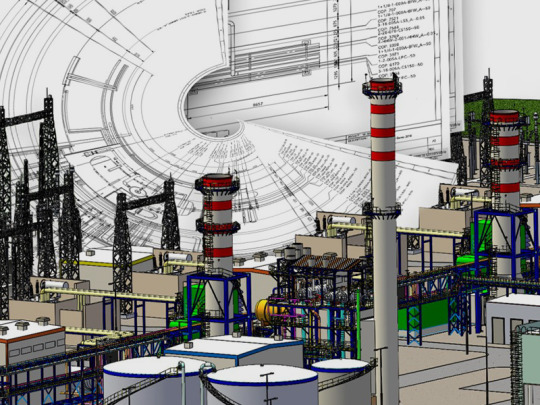
Whether you're a student, an engineer, or just someone curious about how products are brought to life, SolidWorks makes designing easy, fast, and professional. Let’s break down what SolidWorks is and why it’s such a big deal.
What Is SolidWorks?
SolidWorks is a 3D design software that lets you create, test, and improve your ideas—virtually.
Instead of sketching something on paper or building a prototype by hand, you can use SolidWorks to:
• Create digital 3D models of your product • Test how it works under pressure or motion • Make adjustments without wasting materials • Show clients or manufacturers exactly what you’re building
It’s all done inside your computer—and when it’s time to build it for real, your designs are ready to go.
What Can You Design With SolidWorks?
You’d be surprised how many things around you were designed using SolidWorks. It’s used by people in almost every industry:
• Cars and bikes – from engines to outer frames • Airplanes – including wings, turbines, and cabin parts • Boats and marine tools – for both deep sea and leisure use • Phones and cameras – everything from casing to tiny switches • Household gadgets – vacuum cleaners, lighting, fans, and more • Furniture and interiors – cabinets, chairs, and even room layouts • Medical devices – prosthetic limbs, tools, and more • Toys and games – including action figures and plastic kits
If something is built, chances are SolidWorks helped design it first.
Key Features That Make SolidWorks Awesome
Here’s why SolidWorks is a favorite tool among designers and engineers:
• 3D modeling – Draw, shape, and customize 3D objects from scratch • 2D drawings – Turn your models into clean technical drawings • Assembly creation – Combine parts into a working machine or object • Simulation tools – Test how parts move, heat up, or break under pressure • Animation – See how your final design will work in real life • Rendering – Create realistic photos of your 3D model to show off • Design sharing – Export your files to work with teams, clients, or manufacturers
All of this is done with just a few clicks and drags, using tools that are beginner-friendly but powerful enough for pros.
Who Can Use SolidWorks?
The best part? You don’t need to be an expert to start using SolidWorks.
It’s perfect for:
• Engineering students learning design principles • Product developers creating new inventions • Small business owners who want to design their own products • Industrial designers making machines and mechanical parts • Teachers and trainers offering CAD instruction • Freelancers offering design services to companies • Companies in manufacturing, electronics, automotive, and more
Whether you’re just learning or running a full production line, SolidWorks can scale to your needs.
Why SolidWorks Stands Out
There are lots of CAD (Computer-Aided Design) tools out there, but SolidWorks has built a reputation for being powerful and easy to use.
Here’s why people love it:
• Simple interface – Even beginners can figure it out quickly • Fast learning curve – Tons of tutorials and videos available • Accurate output – Get dimensions and designs ready for real-life use • Trusted by companies – Most industries accept SolidWorks files • All-in-one – Design, simulate, and test in the same space
It’s a smart choice whether you’re building a product for fun, for school, or for a full-scale company.
Real-Life Examples of SolidWorks in Action
Still not sure what SolidWorks can do? Check these examples:
• A student uses SolidWorks to model a robot arm for a science fair • A startup designs a new eco-friendly water bottle, testing for leaks • An architect uses it to create custom furniture for an office • A mechanical engineer builds a car engine that works in virtual simulation • A toy maker designs a puzzle with moving parts that snap together perfectly
From small projects to huge machines, SolidWorks helps make ideas real.
Should You Try SolidWorks?
If you’re interested in 3D design, engineering, product development, or even DIY invention, SolidWorks is absolutely worth exploring. It makes designing more fun, more visual, and way more efficient.
You don’t need to build prototypes with cardboard and glue anymore—now, you can design in 3D and test it before building anything physical.
0 notes
Text
Are you looking for Catia training in tambaram?
CADD Centre in Tambaram offers professional and industry-aligned Catia training in tambaram designed for aspiring engineers, designers, and professionals aiming to specialize in CAD/CAM/CAE using Siemens NX software. NX is a powerful and advanced product development solution used by leading manufacturing industries across the globe for design, engineering analysis, and manufacturing. At CADD Centre, students gain hands-on training that equips them with the skills needed to thrive in today’s competitive engineering landscape.
The NX training program at CADD Centre Tambaram covers a wide range of modules including 3D modeling, drafting, surface modeling, assembly design, sheet metal design, and manufacturing (CAM) applications. The course is structured to meet the needs of mechanical, automobile, aerospace, and industrial design professionals and is available for both beginners and experienced candidates.
Learners work on industry-specific assignments that mimic actual engineering problems, thereby enhancing their problem-solving and design thinking capabilities. Training is delivered by certified instructors with rich industry and teaching experience. With personalized attention and structured course materials, students can master complex tools and techniques with confidence.
CADD Centre provides a modern learning environment with access to the latest NX software, high-end systems, and well-equipped labs. The curriculum follows the latest trends and updates from Siemens, ensuring learners stay current with the latest innovations and best practices in the CAD/CAM domain.
In addition to technical training, the center offers placement support, resume building workshops, and mock interviews to help students transition smoothly into employment. Many students from CADD Centre Tambaram have successfully secured positions in top MNCs, engineering consultancies, and design firms.
Flexible batch timings, including weekend and evening classes, make the course ideal for working professionals and college students. Online training options are also available for those who prefer remote learning.
CADD Centre Tambaram is known for its commitment to quality education, strong industry connections, and career-oriented training. Upon successful completion of the NX course, students receive a globally recognized certificate, which adds value to their professional portfolio.
Whether you’re looking to advance your career, start a new profession in design and manufacturing, or enhance your existing skill set, NX training at CADD Centre Tambaram is your gateway to success.
0 notes